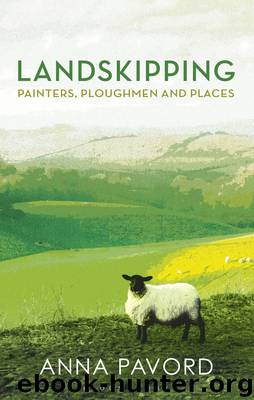LANDSKIPPING by Anna Pavord

Author:Anna Pavord [Pavord, Anna]
Language: eng
Format: epub
Publisher: Bloomsbury Academic
Published: 2015-02-24T16:00:00+00:00
Samuel Palmer, Evening, engraved by Welby Sherman (1834)
CHAPTER 10
Of Rooks and Sheep
Cobbett’s sons, William, John, James and Richard, would have heard their father’s voice too often and so had probably stopped listening to him, but I should like to have ridden alongside Cobbett. He fought the right kind of battles. He was, like many countrymen, wonderfully observant of his surroundings. I would share his appreciation of a good field of cabbages, such as he saw at Colonel Joliffe’s farm at Mearstam. Early Yorks, thought Cobbett, and probably weighing at least three pounds each; for cattle feed, unparalleled. They would be at their best in October, when the grass was beginning to run out. I would have respected and admired his ability to read the agricultural and pastoral landscape, to analyse what each part of it might mean for those whose livelihood it represented. Sheep sound, oaks and hazels very fine, hurdles well made, he observed in the chalk lands round Winchester.
Of course, he wasn’t looking at the land with the geological, the archaeological, the geographer’s underpinning that W. G. Hoskins later brought to The Making of the English Landscape. But he had an intimate and sympathetic appreciation of the work necessary to bring a field of corn safely through to harvest, of the careful process of raising fine beef cattle, worked out over generations of husbandry. And when he got into a rant, as he so frequently did, about Pitt, or plaiting, or paper money, I would just let my mind drift out and away over the fields and woodlands, noting, as he constantly did, the particular comfort represented by the cottages and farmsteads drifting through the sheltered valleys. ‘You feel a sort of satisfaction,’ he wrote, ‘when you are out upon the bleak hills yourself, at the thought of the shelter which is experienced in the dwellings in the vallies.’
And then, Cobbett’s favourite scenes always include sheep and rooks, the two creatures more intimately associated than any other with the English landscape, its moods and seasons. I’m looking at rooks now, in February, hopping between the branches of the larch tree in the garden, snapping off twigs to carry across to the line of alders in the valley below where they nest every season. The ground is littered with twigs blown out from trees in the winter storms, but they never pick up dead twigs from the ground. Not pliable enough, I suppose, nor capable of lasting as a new, freshly gathered twig might. But it’s a laborious enterprise, carried out mostly by the males, since once the collection of twigs begins to look anything like a nest, the female has to sit in it to prevent it being taken over by other gazumping rooks.
The valley, with grassy pastures rising up on either side, is full of the flight of birds. Often we hear the flight, the thwacking whistle of air passing over (through? under?) the ravens’ wings, or the thrilling measured beat of geese or swans flying in a V-formation over the valley.
Download
This site does not store any files on its server. We only index and link to content provided by other sites. Please contact the content providers to delete copyright contents if any and email us, we'll remove relevant links or contents immediately.
The Lonely City by Olivia Laing(4121)
Animal Frequency by Melissa Alvarez(3755)
All Creatures Great and Small by James Herriot(3517)
Walking by Henry David Thoreau(3235)
Exit West by Mohsin Hamid(3184)
Origin Story: A Big History of Everything by David Christian(3139)
COSMOS by Carl Sagan(2950)
How to Read Water: Clues and Patterns from Puddles to the Sea (Natural Navigation) by Tristan Gooley(2857)
Hedgerow by John Wright(2777)
The Inner Life of Animals by Peter Wohlleben(2767)
Origin Story by David Christian(2684)
How to Read Nature by Tristan Gooley(2666)
Project Animal Farm: An Accidental Journey into the Secret World of Farming and the Truth About Our Food by Sonia Faruqi(2661)
How to Do Nothing by Jenny Odell(2645)
A Forest Journey by John Perlin(2588)
Water by Ian Miller(2584)
The Plant Messiah by Carlos Magdalena(2454)
A Wilder Time by William E. Glassley(2364)
Forests: A Very Short Introduction by Jaboury Ghazoul(2335)
